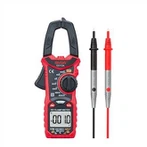What are the general methods for troubleshooting a digital multimeter?
Answer: A digital multimeter is a measuring instrument that uses the principle of analog-to-digital conversion to convert the measured quantity into a digital quantity and display the measurement results in digital form. Compared with pointer type multimeter, digital multimeter has the advantages of high accuracy, fast speed, large input impedance, accurate digital display and reading, strong anti-interference ability, and high degree of measurement automation, and is widely used. But if used improperly, it can easily cause malfunctions.
Troubleshooting a digital multimeter should generally start with the power supply. For example, after turning on the power, if the LCD does not display, the voltage of the 9V stacked battery should be checked first to see if it is too low; Is the battery lead disconnected. Finding faults should follow the order of 'inside first, then outside, easy first, then difficult'. The troubleshooting of a digital multimeter can be roughly carried out as follows:
(1) Appearance inspection:
You can touch the temperature of the battery, resistor, transistor, and integrated block with your hand to check if it is too high. If the newly installed battery heats up, it indicates that the circuit may be short circuited. In addition, it is also necessary to observe whether the circuit is disconnected, desoldered, mechanically damaged, etc.
(2) Detect the working voltage at all levels:
Detect the working voltage at all levels and compare it with the normal value. Firstly, ensure the accuracy of the reference voltage, preferably using a digital multimeter of the same model or similar for measurement and comparison.
(3) Waveform analysis:
Use an electronic oscilloscope to observe the voltage waveform, amplitude, period (frequency), etc. of each key point in the circuit. For example, check if the clock oscillator is on and if the oscillation frequency is 40 kHz. If the oscillator has no output, it indicates that the internal inverter of TSC7106 is damaged, or it may be due to an open circuit in external components. The waveform of the {21} pin of TSC7106 should be a 50 Hz square wave, otherwise it may be due to damage to the internal 200 frequency divider.
(4) Measurement element parameters:
For components within the fault range, parameter values should be analyzed for online or offline measurements. When measuring resistance online, the influence of components in parallel with it should be considered.
(5) Hidden troubleshooting:
Implicit faults refer to faults that appear and disappear from time to time, and the instrument is sometimes good or bad. This type of fault is quite complex, and common reasons include solder joints being loose, loose connectors, poor contact of the transfer switch, unstable component performance, and continuous disconnection of the leads. In addition, it also includes factors caused by external factors. If the ambient temperature is too high, the humidity is too high, or there are intermittent strong interference signals nearby, etc.






